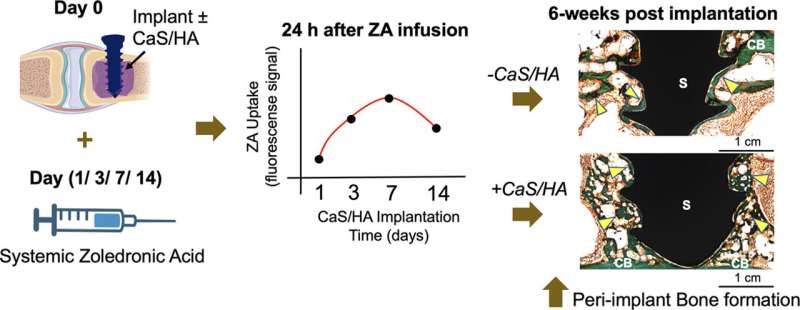This article has been reviewed according to Science X's editorial process and policies. Editors have highlighted the following attributes while ensuring the content's credibility:
fact-checked
peer-reviewed publication
trusted source
proofread
Ceramic material made biologically active may transform into new bone tissue in osteoporotic patients

The Nordic region has the highest incidence of osteoporosis, a disease that makes bone prone to fracture. Age is one of the most important risk factors and Sweden ranks highest in terms of longevity. It is estimated that around 200 million people globally suffer from this silent disease and in Sweden alone about 124,000 osteoporosis-related fractures occur every year.
"If you have reduced bone quality, due to osteoporosis, you have not only an increased risk of fracture but also an increased risk of implant failure, if the fracture needs an operation. Screws may become loose or cut through the weakened bone tissue. Up to 7% of patients with hip fractures undergo additional surgery, which significantly increases the risk of serious complications among an already frail patient group," says Magnus Tägil, professor of orthopedics at Lund University and consultant at Skåne University Hospital.
Together with Deepak Raina, associate professor and researcher in experimental orthopedics at Lund University, he led the study, which involves osteoporosis patients with hip fractures. The findings are published in the journal Acta Biomaterialia.
Instead of conventional surgery using only screws and metal plates, these patients, in addition, received a ceramic bone substitute injection around the orthopedic implant. The material, hydroxyapatite, is a natural component, in bone tissue and in osteoporosis, the resorption of hydroxyapatite increases.
"Our material solidifies within minutes, and immediately improves the strength of the bone anchorage. In a second step, the patient is given an injection of a drug, a bisphosphonate, that finds its way via the bloodstream to the bone mineral, where it binds and activates new bone formation around the implant," says Raina.
Bisphosphonates are a group of drugs that are established and widely used in the prevention and treatment of osteoporotic fractures. They slow the breakdown of bone and reduce the risk of fractures. The study showed that it is important to apply the drug early—preferably three to seven days after the operation.
"Hydroxyapatite and bisphosphonate are both well-established and approved for human use. What we have contributed with is the combination of the two. The material gets ignited and activated, and the osteoporosis patient can start forming new living bone tissue around the implant," says Raina.
Six months after the operation, the patients underwent a DEXA scan, which showed that bone tissue had increased by ten percent around the screw head compared with the control group. DEXA stands for dual-energy X-ray absorptiometry and involves the measurement of bone density using an X-ray based method.
The researchers have carried out experimental studies on rats and a small comparative randomized proof of concept clinical study on patients. The next step is therefore to conduct a larger fracture study on osteoporosis patients in Sweden, and a spinal fracture study in Germany.
They think it could be possible to show that the new method is better than the current treatment, not only in terms of quality of life and reduced risk of additional surgery, but also from a health economics perspective.
The study was led by Lund University in Sweden in collaboration with researchers from Lithuania, Germany and China.
More information: Vetra Markeviciute et al, Systemically administered zoledronic acid activates locally implanted synthetic hydroxyapatite particles enhancing peri-implant bone formation: A regenerative medicine approach to improve fracture fixation, Acta Biomaterialia (2024). DOI: 10.1016/j.actbio.2024.03.005


















